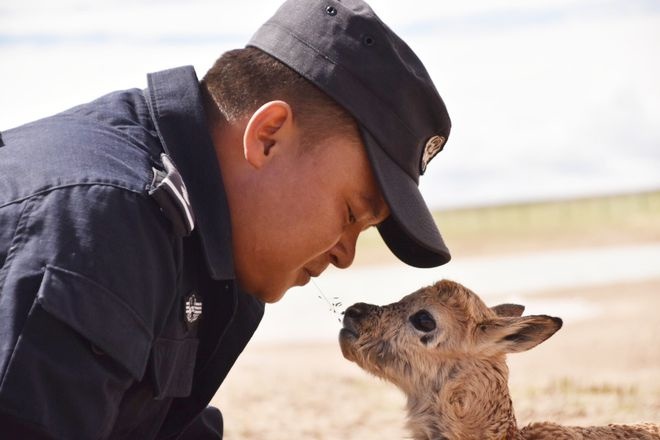
By Jiang Feng, People’s Daily
Legdup Tshegyal, a ranger at the Hoh Xil National Nature Reserve invYushu Tibetan autonomous prefecture, northwest China’s Qinghai province, who always has a big smile on his face, was a little embarrassed to admit that he cried when he first patrolled mountains in Hoh Xil, which is known as “no man’s land”.
Born into a herdsman’s family in Yushu Tibetan autonomous prefecture, LegdupTshegyal has grown up on grasslands and become physically strong.
In 2006, he applied to be a ranger at the Hoh Xil National Nature Reserve. He didn’t realize how difficult it is to patrol the “no man’s land” until did it himself.
The vast Hoh XilNational Nature Reserve, which covers an area of 45,000 square kilometers, has no hardened road.

In summer, he has to patrol along muddy wetlands that seem endless. His car can easily get stuck in the marshy land and couldn’t move a bit. As Hoh Xil is situated at an average altitude of over 4,600 meters, every time he sets out to rescue wild animals in the highland, he is tired out afterwards.
At night, as brown bears occasionally appear outside their tents, LegdupTshegyal and his teammates often need to wave their flashlights back and forth and bang pots and pans to scare away the brown bears.
In winter, the temperature in Hoh Xil can drop to over minus 40 degrees Celsius and the oxygen content here is less than 40 percent of that at the sea level.
The tent becomes as cold as an ice cellar on cold winter night, when trousers wet by the snow usually freeze, and can “stand up” straight on their own when taken off and put on the ground. The harsh conditions in Hoh Xil are beyond imagination.
LegdupTshegyal didn’t cry because of these difficulties. “During the day, I have the company of my teammates; but the long nights are really overwhelming,” he said. It was when he stepped out of his tent and stared into the darkness that he couldn’t help but burst into tears. “I just felt so homesick at that moment,” he recalled.

What he likes about Hoh Xil is that it is a paradise for wild animals. Tibetan antelopes, kiangs, Tibetan gazelles and wild yaks can be seen everywhere in the area. “When I see these precious plateau animals run freely, I feel it is all worth it,” he said.
LegdupTshegyal has guarded Hoh Xil for 16 years, and patrols the highland over 10 times every year. He and his teammates have constituted the biggest deterrent to poachers. Since 2006, no poaching activity has ever been found in Hoh Xil, and the number of Tibetan antelopes here has increased to over 70,000.
Between May and August every year, large flocks of Tibetan antelopes migrate to the side of Zhuonai Lake for parturition. So the SonamDargye Protection Station has been built here for the conservation of the animals, which is the only building for human beings in the “no man’s land”.
LegdupTshegyal and his colleagues stay at the station during the period. He drives along the lakeside, and, whenever he sees a flock of expectant mother Tibetan antelopes, he records in his work diary information about the flock like the number of Tibetan antelopes in the flock, the location where it appeared, and its movement.

In 2019, LegdupTshegyal was awarded China Youth May Fourth Medal, the top honor for outstanding young Chinese people. As a representative of the younger generation of guardians of Hoh Xil, he began to serve as deputy head of the Sonam Dargye Protection Station. While continuing to lead teams in patrol, he has also been responsible for the daily management of the station.
An exhibition center has been built to the north of the Sonam Dargye Protection Station to display the history of wild animal conservation and natural resources in Hoh Xil, which is popular among passersby and tourists along the Qinghai-Tibet Highway.
During the peak tourist season, LegdupTshegyal often acts as a docent at the exhibition center. He is very familiar with Hoh Xil, and always fascinates visitors with his experiences in the area.
When Tibetan antelopes migrate, they need to cross the Qinghai-Tibet Highway. At this time, LegdupTshegyal and his team members become “traffic police” who ensure the safety of Tibetan antelopes. “People driving along the road also voluntarily stop for the animals,” the ranger noted, adding that the idea of harmonious coexistence between man and nature has been deeply rooted in people’s hearts.
There is also a wildlife rescue center inside the SonamDargye Protection Station, which is aimed at saving animals that have been left behind or are sick, and then releasing them into the wild afterwards.
During the parturition season, LegdupTshegyal and his colleagues carefully take care of baby Tibetan antelopes taken in by the rescue center to ensure their health.
Hoh Xil has strengthened LegdupTshegyal’s will and helped him take a steadfast and calm attitude toward life.
It is because of young people like Legdup Tshegyal who have devoted themselves to wildlife conservation that ecological protection in Hoh Xilcan continuously usher in wonderful new chapters.










